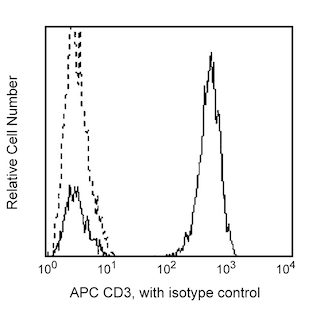-
Your selected country is
Middle East / Africa
- Change country/language
Old Browser
This page has been recently translated and is available in French now.
Looks like you're visiting us from {countryName}.
Would you like to stay on the current country site or be switched to your country?


.png)

Multicolor flow cytometric analysis of human SIRPγ (CD172g) expression on human peripheral blood lymphocytes. Whole blood was stained with APC Mouse Anti-Human CD3 antibody (Cat. No. 555335/561810/561811; Top Plots), FITC Mouse Anti-Human CD19 antibody (Cat. No. 555412/560994; Bottom Plots) and either PE Mouse IgG1, κ Isotype Control (Cat. No. 554680; Left Plots) or PE Mouse Anti-Human SIRPγ (CD172g) antibody (Cat. No. 566353; Right Plots). Erythrocytes were lysed with BD Pharm Lyse™ Lysing Buffer (Cat. No. 555899). Flow cytometric contour plots showing the correlated expression of CD3 (Top Plots) or CD19 (Bottom Plots) versus SIRPγ (CD172g) [or Ig Isotype control staining] were derived from gated events with the forward and side light-scatter characteristics of viable human peripheral blood lymphocytes. Flow cytometric analysis was performed using a BD FACSCanto™ II Flow Cytometer System.
.png)

BD Pharmingen™ PE Mouse Anti-Human SIRPγ (CD172g)
.png)
Regulatory Status Legend
Any use of products other than the permitted use without the express written authorization of Becton, Dickinson and Company is strictly prohibited.
Preparation And Storage
Product Notices
- This reagent has been pre-diluted for use at the recommended Volume per Test. We typically use 1 × 10^6 cells in a 100-µl experimental sample (a test).
- An isotype control should be used at the same concentration as the antibody of interest.
- Source of all serum proteins is from USDA inspected abattoirs located in the United States.
- Caution: Sodium azide yields highly toxic hydrazoic acid under acidic conditions. Dilute azide compounds in running water before discarding to avoid accumulation of potentially explosive deposits in plumbing.
- For fluorochrome spectra and suitable instrument settings, please refer to our Multicolor Flow Cytometry web page at www.bdbiosciences.com/colors.
- Please refer to www.bdbiosciences.com/us/s/resources for technical protocols.
Companion Products






The OX-119 monoclonal antibody specifically recognizes Signal-regulatory protein gamma (SIRP-gamma or SIRPγ) which is also known as CD172g or Signal-regulatory protein beta 2 (SIRP-beta-2 or SIRPβ2). SIRPγ (CD172g) is a ~55 kDa type I transmembrane glycoprotein that is encoded by SIRPG, which belongs to the SIRPβ2 subfamily within the Ig gene superfamily. The SIRPγ (CD172g) extracellular domain contains one amino-terminal IgV-like domain and two IgC-like domains, and a short cytoplasmic region with no known motifs. It is expressed on mature thymocytes, CD4+ T-cells, CD8+ T-cells, CD56-bright natural killer (NK) cells, all activated NK cells and some B cells. SIRPγ (CD172g) binds to CD47 (integrin-associated protein/IAP) that is widely expressed on most hematopoietic cells, epithelial cells, endothelial cells, fibroblasts and many tumor cell lines. SIRPγ (CD172g) may play a regulatory role in T cell-T cell interactions and may induce apoptosis through CD47.

Development References (3)
-
Brooke G, Holbrook JD, Brown MH, Barclay AN. Human lymphocytes interact directly with CD47 through a novel member of the signal regulatory protein (SIRP) family.. J Immunol. 2004; 173(4):2562-70. (Biology). View Reference
-
Piccio L, Vermi W, Boles KS, et al. Adhesion of human T cells to antigen-presenting cells through SIRPbeta2-CD47 interaction costimulates T-cell proliferation.. Blood. 2005; 105(6):2421-7. (Biology). View Reference
-
Vernon-Wilson EF, Kee WJ, Willis AC, Barclay AN, Simmons DL, Brown MH. CD47 is a ligand for rat macrophage membrane signal regulatory protein SIRP (OX41) and human SIRPalpha 1. Eur J Immunol. 2000; 30(8):2130-2137. (Biology). View Reference
Please refer to Support Documents for Quality Certificates
Global - Refer to manufacturer's instructions for use and related User Manuals and Technical data sheets before using this products as described
Comparisons, where applicable, are made against older BD Technology, manual methods or are general performance claims. Comparisons are not made against non-BD technologies, unless otherwise noted.
For Research Use Only. Not for use in diagnostic or therapeutic procedures.
Report a Site Issue
This form is intended to help us improve our website experience. For other support, please visit our Contact Us page.